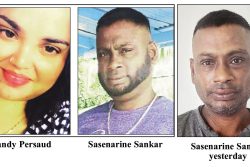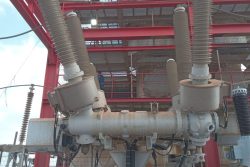Dear Editor,
I write about our sad loss of Engineer J P Lewis, my fellow 1963 DEMBA scholar, to COVID-19 a few days ago. We read that his wife Juliette had succumbed less than two weeks earlier to some pneumonia complications – in the circumstances one could not but wonder whether she might not have been also a COVID-19 victim.
I first met J P Lewis about mid-1963 when we, recent A-Level graduates of Queen’s College and St Stanislaus College respectively, and others were pursuing offers of two ALCAN/DEMBA scholarships. The offers had been published in our local newspapers within a few days of the end of our 1963 eighty-day strike. I recall a number of us meeting-up as we waited our turn at the RACS building for the final interview of the final few. At that time, a good guess would have been that about five percent (5%) of our young people were attaining first degrees – many only possible with scholarships. I recall the late Mike Davis (also a QC boy) remarking that without a scholarship, getting his engineering degree would be that more taxing. The panel of three was constituted of: Mr. J G Campbell, Managing Director of DEMBA; the Head of the RACS – then Mr. N E Cameron who was also deputy Principal of QC (I did wonder about a potential conflict in favour of QC boys); and Chief Justice Luckhoo.
J P Lewis and I were awarded the two DEMBA scholarships to study engineering at the St Augustine (T&T) campus of the then UCWI – a few days later I accepted an alternative place at the University of New Brunswick (UNB) in Canada although it would have taken me a year longer. I recall JP sharing with me his response to the question of what would he like to do for country: his response – to build a set of wooden barges to move bauxite to the Georgetown port for exporting. Over the decades later I would pull his legs saying, pay me something to keep quiet about those wooden barges you still are to deliver. I recall as a close runner-up, Stan Ridley (also of QC)– he enjoyed a successful career ending up at the top of BC Hydro (British Columbia, Canada) in the 1990s. Those were the days when our adult lives lay before us and we all wondered how they would be.
J P graduated and began working at DEMBA in McKenzie in 1966. I arrived there in 1967 and met John and wife and baby son at their residence along Riverside Drive, a row of Staff- houses, just inside of which was perhaps the “best” of the two exclusive 18-hole golf courses – there were stories of errant golf balls sailing over the tall chain-link fence and threatening them and new son.
Those years soon after independence, were filled with great hopes and aspirations and anticipation of opportunities to show how well we could do. In DEMBA, the engineers were perhaps the largest and most active staff group leading the calls for Guyanization and later, supportive of nationalization. Many engineers were also active in the then recently introduced American service organizations – the Jaycees and the Lions. As soon as I had first sat in my office, the late A M B Sankies (another old QC boy) had dumped a carton box of papers on my desk saying “you are now the Honorary Secretary of the McKenzie branch of the Guyana Association of Professional Engineers (GAPE)“ and that I was for the following decade. J P had been active in GAPE and I remember him and other engineering Jaycees laying out the foundations, footings, walls and roof as the St Aidan’s Anglican Church on Burnham Drive, Wismar, was being rebuilt in an unusual oval shape.
JP early departed the bauxite company, about the time of nationalization (July 1971) (about when his four-year gentleman’s commitment to DEMBA would have ended): a civil engineer could easily find more varied and challenging work in Guyana, elsewhere. I have memories of him doing some work for T A Fletcher and Associates from those early days. I recall him working later, the 70s to the 80s, with the Mike Brassington IDEAL venture into local assembly with part manufacture of electric and non-electric household appliances – mainly fridges and stoves. JP would have been working with one of our notable engineers Bert Carter and I visited with them at IDEAL shortly after another of our DEMBA scholars, Stanley V Lachmansingh (a chemical engineer like myself) moved there.
Towards the end of the 1980s, JP was among members of the Rupununi Trail Association (including Terry Fletcher and Peter Fraser), stopping at our place, in Richmond Hill, Linden, at 5:00 hrs in the morning, to enjoy my wife’s breakfast on their forays to the hinterland, to improve the rudimentary cattle trail to the Annai area, so as to provide better transportation for the peanut farmers of the area. It was perhaps only a matter of natural progression that I would next learn of him working with the Mekdeci Mining Company (MMC), with their main operation then on the Konawaruk not far from Mahdia. Andrew Mekdeci had taken some tremendous steps for local small and medium scale miners, to provide a minibus trail to his camp and to greatly upgrade the living conditions in the camp. Many miners and other residents of Mahdia were urging the construction of a branch into Mahdia and I soon found good reason to have GGMC commission the construction of that branch. JP oversaw the extension of the trail from Sucre Junction into Mahdia and that laid the basis for the development of the daily minibus runs between Mahdia and Georgetown. And JP was still with MMC about 2006 when MMC made the Lethem trail a continuous drive of less than 12 hours between Lethem and Georgetown. As a Minister responsible at the time, I acknowledge JP’s contribution in realizing the Mahdia and Lethem roads.
I mentioned earlier that a good guess would be that about 5% of our generation had the opportunity to make it through high school and go on to earn a first degree. A further guess would be that of the 5% doing so less than 20% of us returned to and stayed on in Guyana through our working career. JP had stayed on, and in a varied civil engineering career, sadly and suddenly cut short, he had contributed many times over the equivalent of those wooden barges he had promised that 1963 scholarship panel. As for me, J G Campbell had voiced the concern that with such good grades, he wondered why I was not seeking a career in computers or in rockets: he was concerned that their mundane, foot-in-the-mud-in-the-bauxite mines jobs would not provide me enough intellectual challenge and satisfaction. Fearing that a scholarship could be easily drifting out of my hands (and hence no university) I hastened to assure the panel that I would give my all to those very, mundane, foot-in-the-mud jobs. And so, when in the later 1970s and earlier 1980s people wondered why I was staying on in Guyana, I would reply that I couldn’t get together that scholarship panel again to relieve me of that great swear I had sworn.
Both JP and his wife were very athletic persons and others have been recalling JP’s decades of continuous service in our GDF reserve and in sports, particularly rugby. I found JP to be always cheerful and of good spirits, getting on with the work at hand and I can’t recall ever hearing him express a politically partisan view.
I salute JP as a great example of a true contributing Guyanese of my generation, always trying to make things better; one who persevered and stayed on through some very difficult years, and who would have continued contributing for another decade or more.
Farewell JP
Yours faithfully,
Samuel A A Hinds
Former Prime Minister and
Former President





